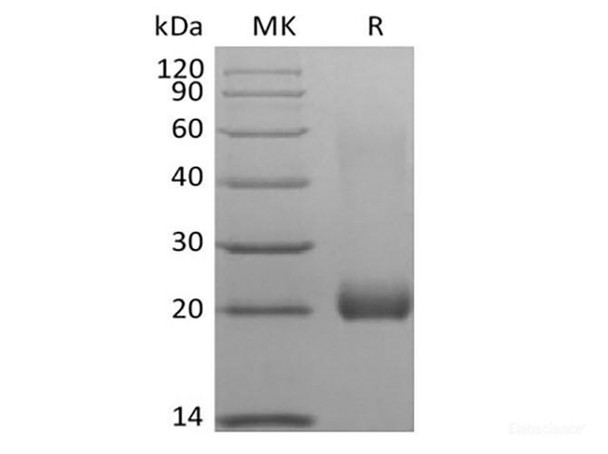Description
| Product Name: | Recombinant Human Leukocyte-associated Immunoglobulin-like Receptor 2/ LAIR2/CD306 (C-Avi-6His) Biotinylated |
| Product Code: | RPES6314 |
| Size: | 20µg |
| Species: | Human |
| Expression Host: | HEK293 Cells |
| Synonyms: | Leukocyte-Associated Immunoglobulin-Like Receptor 2, LAIR-2, CD306, LAIR2 |
| Mol Mass: | 16.7 kDa |
| AP Mol Mass: | 20-25 kDa |
| Tag: | C-Avi-6His |
| Purity: | > 95 % as determined by reducing SDS-PAGE. |
| Endotoxin Level: | < 1.0 EU per μg of the protein as determined by the LAL method. |
| Bio Activity: | Testing in progress |
| Sequence: | Gln22-Pro152 |
| Accession: | Q6ISS4 |
| Storage: | Generally, lyophilized proteins are stable for up to 12 months when stored at -20 to -80°C. Reconstituted protein solution can be stored at 4-8°C for 2-7 days. Aliquots of reconstituted samples are stable at < -20°C for 3 months. |
| Shipping: | This product is provided as lyophilized powder which is shipped with ice packs. |
| Formulation: | Lyophilized from a 0.2 μm filtered solution of 20mM PB, 150mM NaCl, pH 7.2. Normally 5 % - 8 % trehalose, mannitol and 0.01% Tween80 are added as protectants before lyophilization. Please refer to the specific buffer information in the printed m |
| Reconstitution: | Please refer to the printed manual for detailed information. |
| Background: | Leukocyte-Associated Immunoglobulin-Like Receptor 2 (LAIR2) is a secreted, 131 amino acid protein that contains one Ig-like C2 type domain, making it a member of the Ig superfamily. When compared to LAIR-1, its transmembrane counterpart, it shares 83% amino acid identity across the signal sequence and extracellular domains; although one is secreted and one is membrane-bound, the two LAIR proteins are thought to have arisen from a common gene ancestor and appear to share similar adhesion profiles. This suggests that LAIR-2 may compete with LAIR-1 for ligand binding. A 114 amino acid alternate splice form of LAIR-2 is truncated at the C terminus, but retains the entire Ig domain. The expression profile of these splice forms, and the presence of orthologs in other species, have not been reported. |






